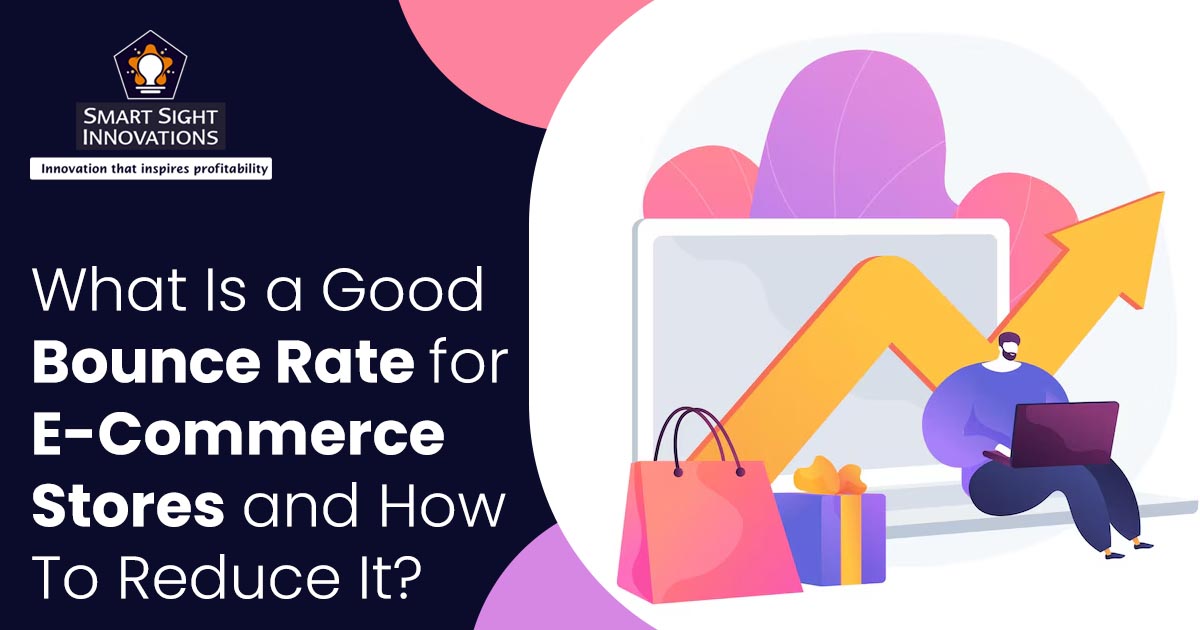
If you’re running an e-commerce store, tracking website bounce rates goes a long way in understanding how customers interact with your store, which could be critical for its success. A bounce rate represents the percentage of visitors who leave a website after viewing only one page, without further interaction.
For online stores, a high bounce rate can signal missed opportunities and potential revenue loss. This article explores what constitutes a good bounce rate for e-commerce stores, factors that influence it, and effective strategies to reduce bounce rates and improve overall website performance and customer engagement.
What Is Bounce Rate?
Bounce rate reflects the percentage of visitors who leave your website after viewing only a single page. In the context of e-commerce, this metric is crucial as it reflects the initial impression visitors have of your online store.
A high bounce rate indicates that many visitors are leaving after viewing just one page, suggesting that the landing page did not meet their expectations or failed to engage them. Conversely, a low bounce rate implies that visitors are finding the content compelling and are exploring additional pages, which is typically desirable for e-commerce sites.
The bounce rate is calculated using the below formula:
| Bounce Rate = | Total Number of Single-Page Visits Total Number of Entries to a Website |
X 100 |
For example, if an e-commerce site receives 1,000 visitors in a month and 400 of these visitors leave after viewing only the landing page, the bounce rate would be:
Bounce Rate = 400/1000 X 100 = 40%
What Is a Good Bounce Rate for E-Commerce Stores?
The acceptable range for bounce rates varies across different types of websites and industries. A bounce rate for e-commerce stores that falls between 20% and 45% is usually regarded as good. Here are some typical benchmarks:
-
20% to 30%
This range is excellent and often indicates that the website is highly engaging, with visitors finding what they are looking for and navigating through multiple pages.
-
30% to 45%
This is an average range for e-commerce sites. While not exceptional, it still suggests that the site is performing adequately. Some improvements could help reduce the bounce rate further.
-
Above 45%
A bounce rate above 45% may indicate that there are issues with the website that need to be addressed, such as slow loading times, poor design, irrelevant content, or technical problems.
Comparing Bounce Rates Across Different Types of E-Commerce Sites
Bounce rate metric varies significantly across different types of e-commerce sites due to differences in user behavior, product types, and website design. Understanding these variations can help businesses tailor their strategies to improve user experience and reduce bounce rates. Regularly analyzing bounce rate data and optimizing the user experience accordingly is crucial for maintaining a competitive edge in the diverse and dynamic world of e-commerce.
1. Fashion and Apparel E-Commerce Sites
Fashion and apparel sites typically enjoy relatively low bounce rates, averaging between 25% and 40%. These sites often feature visually appealing designs, high-quality images, and engaging content that encourage users to explore multiple pages. Fashion shoppers tend to browse through various products, compare styles, and look at different color options, leading to lower bounce rates. Effective use of lookbooks, style guides, and user-generated content also helps keep visitors engaged.
2. Electronics and Gadgets E-Commerce Sites
Electronics sites tend to have moderate bounce rates, typically ranging from 30% to 45%. Consumers visiting these sites often perform detailed research before making a purchase, comparing specifications, reading reviews, and looking for deals. However, the complexity and high price point of electronic products can lead to higher bounce rates if the site fails to provide sufficient information or an intuitive user experience.
3. Health and Beauty E-Commerce Sites
Health and beauty sites usually experience bounce rates between 25% and 35%. These sites often benefit from high user engagement due to the personal nature of the products. Visitors are likely to explore various products, read descriptions, and watch tutorials. Effective use of visuals, testimonials, and personalized content can significantly enhance user engagement.
4. Home and Furniture E-Commerce Sites
Home and furniture sites generally have higher bounce rates, averaging between 30% and 50%. The purchasing process for these products is often more involved, requiring significant consideration and research. Large images, augmented reality features, and comprehensive product descriptions are essential to help potential customers visualize how products will look in their spaces.
5. Grocery and Food Delivery E-Commerce Sites
Grocery and food delivery sites typically have lower bounce rates, often between 20% and 35%. These sites cater to repeat purchases and frequent visits, resulting in higher user engagement. Clear navigation, easy reordering options, and personalized recommendations based on past purchases help keep bounce rates low.
6. Luxury Goods E-Commerce Sites
Luxury goods sites can experience a wide range of bounce rates, from 20% to 50%, depending on their target audience and the exclusivity of their products. These sites need to offer a premium user experience with high-quality visuals, detailed product descriptions, and exceptional customer service. The higher consideration involved in purchasing luxury items can lead to higher bounce rates if the site does not meet the expectations of its discerning customers.
Signs of a High Bounce Rate
A healthy bounce rate for your e-commerce store is essential for success. By recognizing these signs, you can start to diagnose the bounce rate problem plaguing your e-commerce store. Below are some signs of a high bounce rate:
- Every industry has an average bounce rate. If yours is significantly higher than the norm for your niche, it’s a strong indicator of potential problems.
- Bounce rate often goes hand-in-hand with low session duration. Visitors who bounce typically spend very little time on your website, often just a few seconds.
- High bounce rate often signifies a lack of engagement with your website’s content. Visitors aren’t clicking through to explore other product pages, categories, or informational sections. Look at your average number of page views per session. A low number suggests visitors aren’t finding reasons to stay and delve deeper into your store.
Factors Influencing Bounce Rate in E-Commerce
Several factors can influence the bounce rate of an e-commerce store:
1. Page Load Speed
Slow-loading pages are one of the main reasons for high bounce rates. As page load time goes from 1 second to 3 seconds, the probability of bounce increases by 32%. Ensuring that your site loads quickly can significantly reduce bounce rates.
2. Mobile Optimization
With the increasing number of users shopping on mobile devices, having a mobile-optimized website is crucial. Non-responsive sites or those that offer a poor mobile experience can drive visitors away quickly.
3. Content Relevance
Visitors should find relevant and engaging content that matches their search intent. If the landing page content does not meet visitors’ expectations, they are likely to leave without exploring further.
4. User Experience and Design
Having a simple, clean layout with easy navigation helps keep visitors engaged. Confusing layouts, intrusive pop-ups, and complicated menus can increase bounce rates.
5. Clear Calls-to-Action (CTAs)
Effective CTAs guide visitors towards the next step, whether it’s browsing products, signing up for a newsletter, or making a purchase. Poor or vague CTAs can result in higher bounce rates.
6. Product Information
Providing detailed and accurate product descriptions, high-quality images, and customer reviews can help retain visitors. Insufficient or poor-quality information can cause visitors to leave.
Is a High Bounce Rate Bad?
A high bounce rate in your e-commerce store can have a significant negative impact, affecting everything from sales to search engine ranking. Some of the key consequences are:
-
Lost Sales Potential
A high bounce rate suggests visitors are leaving your website without exploring products or making purchases. This translates to missed sales opportunities.
-
Engagement Issues
A high bounce rate indicates a lack of connection with your website. Visitors might find the content irrelevant, navigation confusing, or the website slow to load, leading them to abandon ship.
-
SEO Impact
Search engines like Google consider bounce rate as a factor in website ranking. A high bounce rate might signal a poorly designed or irrelevant website, potentially lowering your search ranking and reducing organic traffic.
-
Brand Image
A high bounce rate can negatively impact your brand image. Visitors who have a frustrating experience might associate your brand with a poorly designed or confusing website, potentially leading them to choose a competitor.
-
Wasted Marketing Budget
If you’re investing in advertising to drive traffic to your website, a high bounce rate suggests you’re not converting that traffic into sales. This essentially means you’re wasting your marketing budget.
How to Improve Bounce Rate in E-Commerce
Improving bounce rate in e-commerce is crucial for enhancing user engagement, increasing time spent on the site, and ultimately boosting conversion rates. Here are several effective strategies to help reduce bounce rates and improve overall site performance:
1. Optimize Page Load Speed
As users expect fast, responsive websites, they are likely to leave if a page takes too long to load. Here are some ways to optimize page load speed:
- Use tools like TinyPNG to reduce image size without compromising quality.
- Activate caching to reduce load times for returning visitors.
- Minimize HTTP requests and reduce the number of elements on your page to decrease load time.
- Use Content Delivery Networks (CDNs) and distribute your content across various servers to improve load times for global users.
2. Enhance Mobile Experience
With the growing number of users shopping on mobile devices, having a mobile-optimized website is essential. Poor mobile experience can lead to higher bounce rates. Mobile experience can be enhanced through:
- Ensuring your website adjusts seamlessly to different screen sizes.
- Using a simple, intuitive menu structure that’s easy to navigate on smaller screens.
- Optimizing touch elements by making buttons and links large enough to tap easily.
3. Create High-Quality, Relevant Content
Content that meets visitors’ expectations and needs keeps them engaged and reduces bounce rates. High-quality and relevant content can be created by:
- Aligning your content with what users are searching for and interested in.
- Crafting compelling headlines that grab attention and entice users to read more.
- Using images, videos, and infographics to make content more engaging and easier to digest.
4. Improve Website Navigation
Complicated or confusing navigation can frustrate users and cause them to leave your site. Some tips to improve website navigation are:
- Use a well-organized menu with clear categories.
- Implement breadcrumbs to help users understand their location within the site and easily navigate back to previous pages.
- Provide a robust search feature to help users quickly find what they’re looking for.
5. Use Clear Calls-to-Action (CTAs)
Effective CTAs guide visitors towards desired actions, such as browsing products, signing up for newsletters, or making a purchase.
- Position CTAs prominently where users are likely to see them.
- Use action-oriented language that clearly communicates the benefit of clicking the CTA.
- Make sure CTAs stand out visually from the rest of the content.
6. Enhance Product Pages
Detailed and visually appealing product pages can significantly reduce bounce rates by providing users with the information they need to make a purchase decision.
- Make use of several high-quality pictures that showcase the goods from various perspectives.
- Provide comprehensive product descriptions, including features, benefits, and specifications.
- Add client testimonials and ratings to establish credibility and offer social evidence.
7. Implement Exit-Intent Popups
Exit-intent popups can capture the attention of visitors about to leave your site and potentially keep them engaged. This can be done by:
- Provide discounts, special offers, or free shipping to encourage visitors to stay or complete a purchase. This can also contribute to increased order values over time.
- Use exit-intent popups to gather feedback on why users are leaving, which can provide insights for further improvements.
8. Utilize Internal Linking
Internal linking helps guide users to other relevant content or products, keeping them on your site longer.
- Add links to related products or blog posts within your content.
- Use internal links to direct users to best-selling or popular items.
9. Analyze and Optimize with A/B Testing
A/B testing allows you to test different versions of your pages to see which performs better in terms of reducing bounce rates.
- Try out various CTAs, layouts, headlines, and picture choices.
- Use data from A/B tests to determine which changes have the most significant impact on reducing bounce rates.
Web Technologies for Testing User Behavior
Understanding user behavior is crucial for optimizing your e-commerce website and reducing bounce rate. Here are some key web technologies that can help you gain valuable insights:
1. Google Analytics
Google Analytics provides comprehensive data on user behavior, including bounce rate, session duration, page views, and visitor demographics. You can use it to identify pages with high bounce rates and track the impact of optimization efforts.
2. Heatmaps & Session Recordings
Tools like Hotjar and Crazy Egg create visual representations of user clicks, scrolls, and mouse movements. Session recordings allow you to literally watch how visitors navigate your website, uncovering usability issues that might not be readily apparent from traditional analytics data.
3. A/B Testing Tools
A/B testing allows you to compare different versions of website elements (e.g., product pages, CTAs) to see which one performs better. These tools help you identify the most user-friendly and conversion-optimized versions of your website content.
4. SurveyMonkey & Hotjar Surveys
Gathering user feedback directly can provide valuable insights into their experience with your website. Surveys can be used to ask specific questions about ease of navigation, product information clarity, or overall website satisfaction.
5. Eye-Tracking Software
This technology tracks where users look on your website, revealing areas of interest and potential points of confusion. While more expensive than other options, it can be invaluable for understanding user attention patterns.
6. User Testing Platforms
Services like UserTesting.com allow you to recruit real people to perform tasks on your website and provide feedback. This can provide valuable insights into real-world user behavior and identify usability issues you might miss with automated tools.











